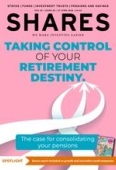Archived article
Please note that tax, investment, pension and ISA rules can change and the information and any views contained in this article may now be inaccurate.
Building your first portfolio is easier than you might think

It can seem daunting to know where to start when making a first investment which may deter some people from starting at all. This would be a mistake because the sooner a start is made, the longer an investment is allowed to mature and provide capital gains and dividends.
Waiting just a few years can reduce the potential saving pot over the long term. For example, assuming an investment of £100 a month earns 7% a year, waiting just four years to start reduces the investment pot by around 25%, over 40 years.
This is equivalent to a difference of £65,000 over that period. This article provides some pointers on how to think about building a portfolio for the first time.
Apart from starting as early as possible, the next consideration is building a diversified portfolio. Diversification is an important principle in finance and sometimes referred to as the only ‘free lunch’ available to investors.
Greater diversification reduces volatility (how much the portfolio’s value moves up and down) and smooths out investment returns. A good rule of thumb is to aim for populating a portfolio with at least 25 individual stocks.
Using the same £100 a month investment example, this equates to a £1,200 investment over one year which implies investing £48 in each investment.
It is challenging to invest small amounts because the costs can render it uneconomic. Trading costs alone can be as much as £10 while the dealing spread,(difference between buying and selling price) also needs to be considered. It is also worth remembering that stamp duty is payable at a rate of 0.5% on purchases of UK shares.
On top of the cost side of the equation, conducting research on 25 different investments can be time consuming. Fortunately, there are simpler and cheaper solutions for achieving diversification when starting out.
Ready-made diversification and exposure to leading market indices can be found via actively managed and passive funds, investment trusts and ETFs (exchange traded funds). These investments can form the bedrock of a portfolio with individual shares added later to provide even greater diversity and growth and income potential.
STARTER PORTFOLIOS
If you do not have the time or interest to do your own portfolio planning, ready-made portfolios can be a decent alternative. AJ Bell has four ‘starter portfolios’ to suit cautious, balanced, adventurous and income-focused investors. Note these are currently only available to new rather than existing AJ Bell customers. Judging where you sit across the range of options will largely depend on how long you are planning to invest for but also on your temperament.
This applies across the board with investing. You will need to make a minimum initial investment of £1,000 and you’ll kick off with a group of five to nine products from AJ Bell’s ‘Favourite funds’ list which fit your chosen category.
These starter portfolios are updated by AJ Bell and you have the power to update your own portfolio too. This makes them a useful starting point which you can build on as you become more confident in your investing. You’ll pay £1.50 each time you buy or sell a fund, and a 0.25% custody charge (tiered down to zero) per year for holding the funds.
ONE STOP SHOPS
Novice investors with neither the time nor inclination to research individual stocks might prefer to leave the decisions to the experts, and this is where ‘one stop shop’ funds can have a role to play.
These products are designed to give investors everything they need under one roof and tend to be multi-asset, which means they own shares and bonds, and can sometimes give access to commodities or property, while avoiding anything too exotic that could suddenly blow a hole in performance.
The funds tend to be globally focused which provides access to greater diversification and enhanced growth opportunities relative to those available in the UK stock market.
F&C Investment Trust (FCIT) is one of the oldest investment trusts and has increased its dividend for 53 successive years. It provides long-term capital growth and income from an ultra-diversified fund invested in over 400 companies across 35 countries.
Capital preservation trusts such as Ruffer (RICA) and Personal Assets (PNL) have some attractions as one stop shops. They are invested across different asset classes and aim to provide capital protection and long-term capital growth.
USING TRACKERS TO START A PORTFOLIO
A no hassle, diversified, cost-efficient way of building a portfolio is to use exchange-traded funds or ETFs and index fund trackers. An ETF is a pooled investment vehicle which, like a fund, offers investors a proportionate share in a pool of stocks, bonds, and other assets.
Unlike a fund whose shares are priced daily based on the value of its assets, an ETF can be bought or sold throughout the day on a stock exchange at a market-determined price. This is the main difference between ETFs and index trackers which price once per day.
The hardest challenge with building a portfolio through ETFs is determining an appropriate amount to put into each asset class, from riskier assets like shares to lower risk assets like bonds.
Every investor should try to build a portfolio which suits their individual risk appetite. It is better to aim for a balanced portfolio initially and once more confidence and experience is gained, weightings can be adjusted to suit changing risk appetites or developing areas of expertise.
Age is also a factor to consider. Someone in their 20s, 30s or 40s may prefer to have a lower weighting to bonds, as they have time on their side to ride the ups and downs of the stock market.
Stocks have historically produced better returns than bonds but with more variability. Bond returns have been lower but more stable than stocks.
A balanced portfolio would aim for 60% in stocks and 40% in bonds. It is worth pointing out this once popular approach has come under fire in recent years as rising inflation has had a big negative impact on bond returns.
That does not mean the relative security of a fixed bond income security has lost any of its appeal. In this context, it is worth pointing out that while prices move around during the life of a bond, on maturity investors should expect to receive their capital back.
BUILDING BLOCKS OF A PORTFOLIO
Below we look at some ETF options for portfolio construction, taking in assets like stocks, bonds, commodities, property and infrastructure.
STOCKS
Global stock ETFs tend to track either the MSCI World index or the FTSE World index, index creations of the two largest index providers, MSCI (MSCI:NYSE) and the London Stock Exchange (LSEG), respectively.
The Vanguard FTSE-All World ETF (VWRP) tracks the latter and has a total expense ratio of 0.22% a year. The FTSE World index tracks stocks from developed and emerging countries worldwide.
The ETF has almost £10 billion in assets and the manager aims to replicate performance of the index by buying the most relevant index constituents.
BONDS
The Bloomberg Global Aggregate Bond index is comprised of over 15,000 investment grade bonds issued in emerging and developed markets worldwide and used by fund managers as a broad-based benchmark for global bonds.
An efficient way to track the index is via the iShares Core Global Aggregate Bond ETF USD Hedged (AGGU). The ETF has a total expense ratio of 0.1% a year, making it one of the cheapest ways to track global bonds across all maturities.
PROPERTY AND INFRASTRUCTURE
Investors could consider adding some extra spice and diversity by investing in property and infrastructure ETFs. These asset classes provide some inflation protection along with stable, predictable income.
With central banks leaning towards easing tight monetary policies as inflation continues to ease, these assets are very interest rate sensitive and should benefit from lower interest rates.
The iShares UK Property ETF (IUKP) tracks the FTSE EPRA/NAREIT United Kingdom index which itself tracks UK listed real estate companies and trusts.
The £623 million fund is invested across 41 holdings and has a total expense ratio of 0.4% a year.
In the infrastructure space investors could consider the iShares Global Infrastructure ETF (INFR) which tracks the FTSE Global Core Infrastructure index, comprised of the largest global infrastructure stocks.
The £1.11 billion fund has 257 holdings and an ongoing charge of 0.65% a year with the manager fully replicating the underlying index. The fund pays out dividends quarterly and has a trailing dividend yield of 2.48%.
DISCLAIMER: Financial services firm AJ Bell referenced in this article owns Shares magazine. The author (Martin Gamble) and editor (Tom Sieber) own shares in AJ Bell.
Important information:
These articles are provided by Shares magazine which is published by AJ Bell Media, a part of AJ Bell. Shares is not written by AJ Bell.
Shares is provided for your general information and use and is not a personal recommendation to invest. It is not intended to be relied upon by you in making or not making any investment decisions. The investments referred to in these articles will not be suitable for all investors. If in doubt please seek appropriate independent financial advice.
Investors acting on the information in these articles do so at their own risk and AJ Bell Media and its staff do not accept liability for losses suffered by investors as a result of their investment decisions.
 magazine
magazine








